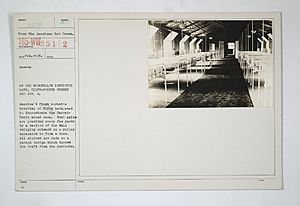Henry Drysdale Dakin facts for kids
Quick facts for kids
Henry Drysdale Dakin
|
|
|---|---|

Portrait. Credit:Wellcome Science Museum Group
|
|
| Born | 12 March 1880 London, England
|
| Died | 10 February 1952 (aged 71) Scarsdale, New York, United States
|
| Nationality | English |
| Alma mater | University of Leeds |
| Known for | Carrel-Dakin method Dakin reaction Dakin–West reaction |
| Awards | Davy Medal (1941) Fellow of the Royal Society (1917) |
| Scientific career | |
| Institutions | University of Leeds, University of Heidelberg, Columbia University |
| Doctoral advisor | Julius B. Cohen, Albrecht Kossel |
Henry Drysdale Dakin (born March 12, 1880 – died February 10, 1952) was an important English chemist. He was known for his work on wound treatments and for discovering new chemical reactions.
Contents
Early Life and Education
Henry Dakin was born in London, England. He was the youngest of eight children. His family were steel merchants from Leeds. Even as a schoolboy, he showed an interest in science. He helped analyze water with the Leeds City Analyst.
He studied chemistry at the University of Leeds. His teacher there was Julius B. Cohen. Later, he worked with Albrecht Kossel at the University of Heidelberg in Germany. There, he studied a special protein called arginase.
Moving to America
In 1905, Henry Dakin moved to the United States. He joined Columbia University in New York City. He worked in the lab of Christian Herter. While working on amino acids, which are the building blocks of proteins, he earned his PhD degree from the University of Leeds.
In 1905, he was one of the first scientists to successfully create adrenaline in a lab. Adrenaline is a hormone that helps your body react to stress.
Contributions During World War I
In 1914, when World War I began, Henry Dakin returned to England. He wanted to help with the war effort. A scientist named Alexis Carrel needed a chemist for a temporary hospital in France. So, in 1916, Dakin joined Carrel in Compiègne, France.
The Carrel–Dakin Method
Together, Dakin and Carrel developed a new way to treat wounds. This method was called the Carrel–Dakin method. It involved regularly washing wounds with a special liquid called Dakin's solution. This solution was a weak mix of sodium hypochlorite (the main part of bleach) and boric acid.
Dakin tested over 200 different substances to find the best one. He also created ways to measure how well they disinfected wounds and helped them heal. Dakin's solution is still used today to clean wounds.
The Rockefeller War Demonstration Hospital in the United States was even created to promote this new treatment. It was a school to teach military surgeons how to use the Carrel-Dakin method.
Later Research and Discoveries
In 1916, Henry Dakin married Christian Herter's widow. After that, he worked in his own private lab in Scarsdale, New York. He often worked closely with other scientists.
His main areas of study were amino acids and enzymes. Enzymes are special proteins that speed up chemical reactions in the body. He found a way to get amino acids from broken-down proteins using a chemical called butanol.
He was also very interested in organic chemistry, which is the study of carbon-based compounds. He discovered two important chemical reactions: the Dakin reaction and the Dakin–West reaction. These reactions are still used by chemists today to create new substances.
Henry Dakin passed away in early 1952, shortly after his wife.


